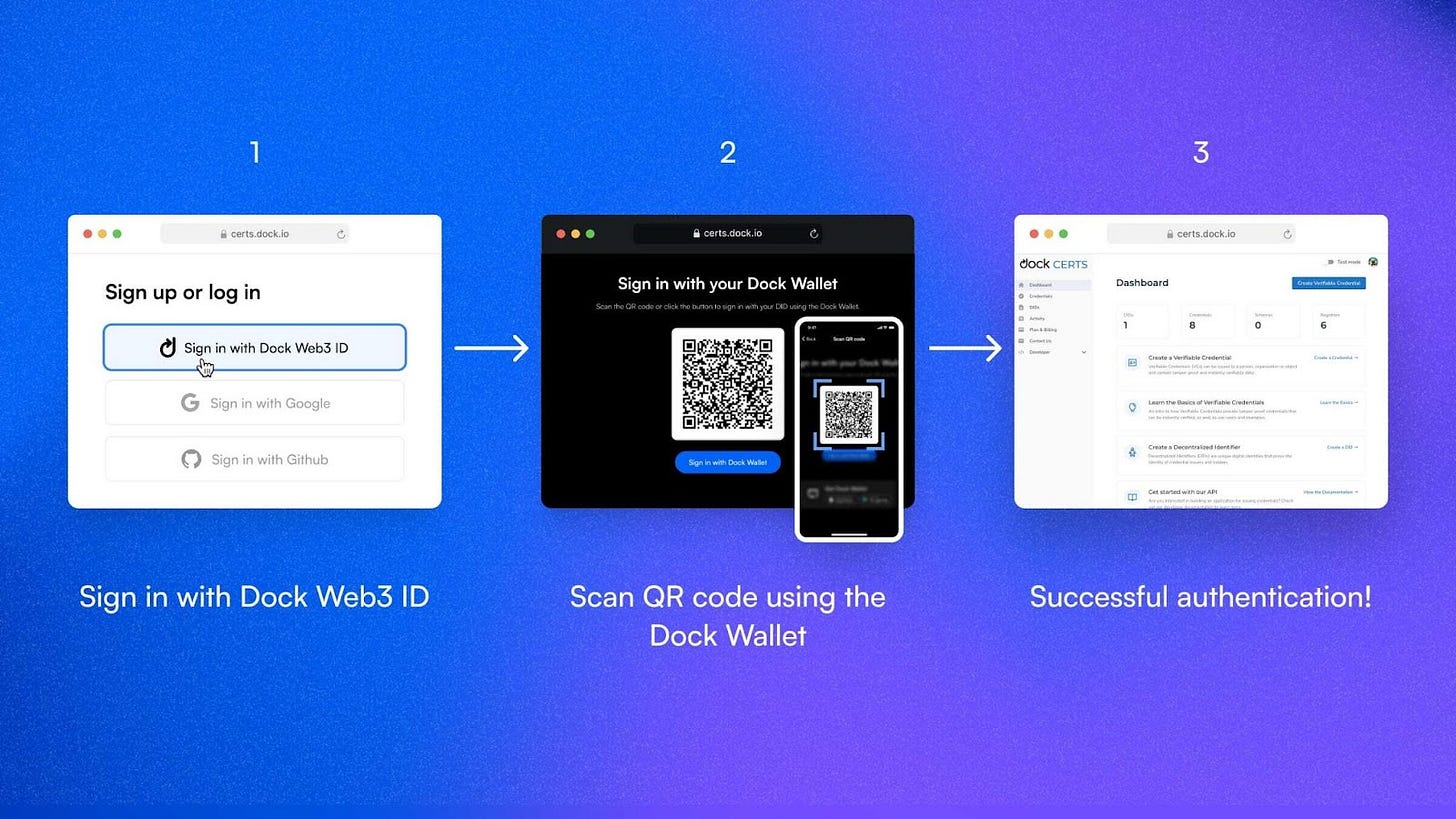Web3 IDs Launched, DIDs Explained, and More
The launch of Dock Web3 IDs, explanations of Decentralized Identifiers, the role of Dock blockchain and more
Dock launches Web3 ID
We are delighted to announce that we have launched Web3 ID!
Web3 ID is a blockchain-based authentication and authorization system that puts user privacy first. Developers can grant access and verify end-user eligibility by requesting private data from users' non-custodial identity wallet apps and this is always done with users’ consent.
Web3 ID gives users full control and ownership of their digital identity, prevents user tracking and correlation (data can be traced back to someone's identity), and gives users the option to authenticate without revealing personal data.
“Web3 ID is essential in fulfilling the vision of Self-Sovereign Identity that gives people full control and ownership over their digital identity. We’ve developed game-changing technology that enhances security, efficiency, and privacy for individuals, developers, and organizations.”
–Nick Lambert, CEO at Doc
It combines the ease of QR code scanning with the security of Public-Key Cryptography. Web3 ID allows the user to create as many DIDs as they want. They can even use a different DID for each website or application they connect with, preventing user tracking and data correlation.
By scanning the QR code, users receive a notification in their identity wallet apps about what data is being requested. Users can privately share the required credentials with one tap on their phones.
Read the full announcement here.
Watch the announcement video here.
What is a Decentralized Identifier (DID)? And why do we need it?
Identity management has been a major concern since the internet was invented. Billions of dollars have been spent on providing a private and secure space for digital transactions.
According to Statista, the global identity and access management market had risen to nearly $13.92 billion by 2021. Even with this level of investment, managing digital identities has been complicated, challenging, and expensive.
In a centralized identity management system, users' data/credentials are stored in centralized and siloed databases, and for popular services, this can be a lot of user data. Should a hacker gain access to these centralized systems, they can gain access to millions of users’ credentials.
Platforms like Facebook utilize centralized and federated identity systems. A federated system allows users to login to websites and services using their credentials from other platforms, i.e. login with Facebook. How many times have we heard of Facebook data breaches where the privacy of millions of users was compromised? These issues highlight the risks associated with centralized, federated, and digital identity management systems.
Decentralized identity systems like Dock’s Web3 ID allow users to gain control, store, and manage their own identities and data.
Decentralized Identifiers (DID) explained
DIDs are cryptographically verifiable identifiers stored on the blockchain and independent of any organization. In Web2, users sign in with centralized identifiers like email addresses and social media profiles. In Web3, users create and own their Decentralized Identifiers (DIDs). With Web3 authentication, a Decentralized Identifier is used.
Users can have as many DIDs as they want which prevents correlation and tracking. Using different DIDs helps to ensure that companies like Google and Facebook can’t track data back to a user. To enhance data security, someone can create a DID for professional purposes where they give permission to share their educational credentials while applying for a job and use another DID that’s only used to access online gaming websites.
This demonstrates how Web3 technology can enable you to keep your online footprint secure and private at the same time.
In simple words, a DID:
Doesn’t contain personal data or wallet information
Allows the owner to prove cryptographic control over it
Is interoperable across apps and websites
Can connect to multiple Verifiable Credentials that contain cryptographically secured user data
Enables private and secure connections between two parties and can be verified anywhere at any time
Note - DIDs contain no personal data or wallet information.
How does Blockchain help?
As we mentioned earlier, DIDs are cryptographically ‘verifiable’ identifiers, stored on the Dock blockchain. The Dock blockchain doesn’t store any personal user data connected to your DIDs or Web3 IDs. The blockchain only maintains a database of public keys of all users. You will always be in control of your private key to access your DID.
Not your keys, not your ID…
This also means every data that has been linked to your DID can be accessed only with your permission. Users decide how and what data to share using privacy-preserving techniques.
Coming to the main part, the Dock blockchain plays a key role in the verification process. Verifiable Credential is a solution that allows organizations to issue digital credentials and sign them cryptographically. This digital signature can be verified with blockchain.
The decentralized and immutable nature of the blockchain’s database ensures that Verifiable Credentials are always available for authentication.
If you want to dive further deeper into Decentralized Identity, we have a free certification course available. All you need to do is watch all the videos, complete the quiz, and if you pass, we will send you your course certificate as a Verifiable Credential.
Exciting isn’t it?
That’s all for our first ‘Web3 in brief’ edition.
Let’s end it with some fun memes because we all love them, why not!
Dock Meme of the Month
Created by our community members
Web3 Meme of the Month
And last but not least, we recently launched our Technology page and a complete Crypto Guide about our project that you can find below:
You can buy DOCK on:
Don’t forget to follow us on:









